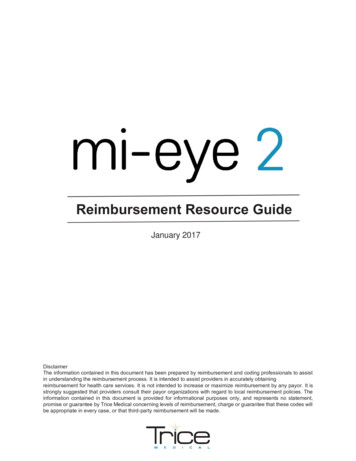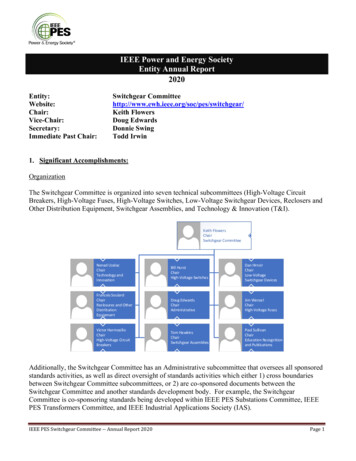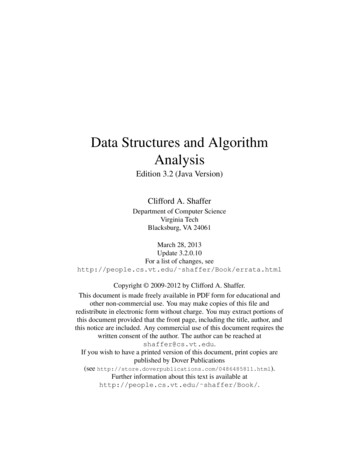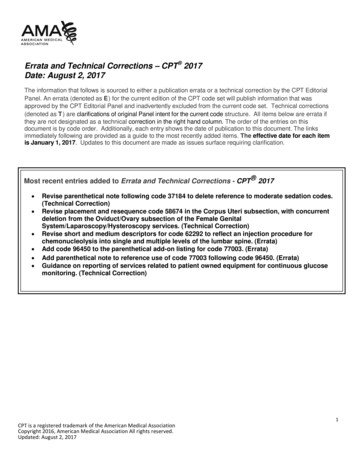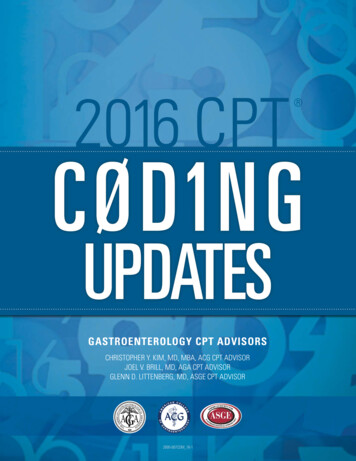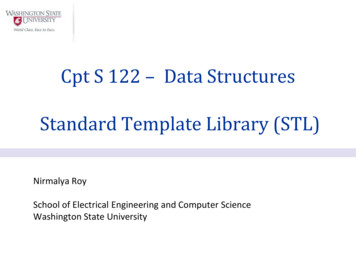
Transcription
Cpt S 122 – Data StructuresStandard Template Library (STL)Nirmalya RoySchool of Electrical Engineering and Computer ScienceWashington State University
Topics Introduction to Standard Template Library (STL)Introduction to Containers Introduction to Iterators Templated data structurevector, list, deque; set, multiset, map,multimap; stack, queue, priority queueAccess the elements of STL containersIntroduction to Algorithms Program with many STL algorithmsequal, size, find, remove, replace,min, max, swap, basic searching, sortingalgorithms
Introduction to the Standard TemplateLibrary (STL) The Standard Template Library (STL) defines powerful,template-based, reusable components.Implement many common data structures andalgorithms used to process those data structures.The STL was conceived and designed for performanceand flexibility.STL has three key components containers (popular templatized data structures)iterators (to access the elements of STL containers)algorithms (searching, sorting, comparing etc)
Advantage of STL Data structures. Pointer-based code is complex linked lists, queues, stacks and trees.objects are linked together with pointers.the slightest omission or oversight can lead to serious memory-accessviolations and memory-leak errors with no compiler complaints.Implementing additional data structures, such as deques,priority queues, sets and maps, requires substantial extrawork.An advantage of the STL is that you can reuse the STLcontainers, iterators and algorithms implement common data structures and manipulations project-wide.
STL PillarsContainersIteratorsAlgorithms
STL Containers Each STL container has associated member functions. A subset of these member functions is defined in all STLcontainers.Example of STL containers vector (adynamically resizable array)list (a doubly linked list)deque (a double-ended queue, pronounced “deck”). Double-ended queues are sequence containers with dynamic sizesthat can be expanded or contracted on both ends (either its front orits back).individual elements are accessed directly through random accessiterators
STL Iterators STL iterators Standard arrays can be manipulated by STL algorithms using standard pointers as iterators.Manipulating containers with iterators is convenient properties similar to those of pointersused by programs to manipulate the STL-container elements.provides tremendous expressive power combined with STL algorithmsreduce many lines of code to a single statement.There are five categories of iterators input,output,forward,bidirectional,random.
STL Algorithms STL algorithms are functions that perform common datamanipulations searching, sorting and comparing elements (or entire containers) etc.Each algorithm has minimum requirements for the types ofiterators that can be used with it.Each first-class container supports specific iterator types,some more powerful than others.A container’s supported iterator type determines whether thecontainer can be used with a specific algorithm.
Containers The STL containers are divided into three majorcategories sequence containersassociative containerscontainer adaptersThere are three styles of container classes first-class containersadaptersnear containers
Containers Types and Examples
Containers Types and Examples
Containers Types The sequence containers represent linear data structures The associative containers are nonlinear containers locate elements stored in the containers quicklystore sets of values or key/value pairs.The sequence containers and associative containers arecollectively referred to as the first-class containers.Stacks and queues actually are constrained versions ofsequential containers. vectors and linked lists.STL implements stacks and queues as container adaptersenable a program to view a sequential container in a constrainedmanner.near containers C-like pointer-based arrays, bitsets for maintaining sets of flag valuesexhibit capabilities similar to those of the first-class containers, but donot support all the first-class-container capabilities.
Containers’ Common Member Functions Most STL containers provide similar functionality.Many generic operations, such as member function size,apply to all containers other operations apply to subsets of similar containers.encourages extensibility of the STL with new classes.[Note: Overloaded operators , , , , and ! arenot provided for priority queues.]
Containers’ Common Member Functions
Containers’ Common Member Functions
Common Member Functions
Container Headers
Container typedefs
Container typedefs These typedefs are used in generic declarationsof variables, parameters to functions and returnvalues from functions.
Introduction to Iterators Iterators have many similarities to pointers Certain iterator operations are uniform across containers.For example, the dereferencing operator (*) dereferences aniterator point to first-class container elements.get the element to which it points.The operation on an iterator moves it to the container’s nextelement
Iterators STL first-class containers provide member functionsbegin and end.Function begin returns an iterator pointing to thefirst element of the container.Function end returns an iterator pointing to the firstelement past the end of the container (an elementthat doesn’t exist).
Iterators Iterator i points to a particular element The iterator resulting from end is typically used inan equality or inequality comparison i points to the “next” element*i refers to the element pointed to by idetermine whether the “moving iterator” (i in this case)has reached the end of the container.An object of type iterator refers to a containerelement that can be modified.An object of type const iterator refers to acontainer element that cannot be modified.
Iterators Categories Different categories of STL iterators. Each category provides a specific set of functionality.The hierarchy of iterator categories. each iterator category supports all the functionality of thecategories above it.the “weakest” iterator types are at the top and the mostpowerful one is at the bottom.this is not an inheritance hierarchy.
Iterators Categories
Predefined iterator typedefs found in the class definitions of the STL containers.Not every typedef is defined for every container.Use const versions of the iterators for traversing read-onlycontainers.Use reverse iterators to traverse containers in the reversedirection.
Introduction to Algorithms STL algorithms can be used generically across a variety ofcontainers.STL provides many algorithms to manipulate containers. inserting, deleting, searching, sorting etc.The algorithms operate on container elements only indirectlythrough iterators.Many algorithms operate on sequences of elements defined bypairs of iterators one pointing to the first element of the sequenceone pointing to one element past the last element
Introduction to Algorithms Algorithms often return iterators that indicate theresults of the algorithms.Algorithm find locates an element and returns an iterator to that element.If the element is not found, find returns the “one past theend” iterator.The find algorithm can be used with any first-classSTL container.Some algorithms demand powerful iterators; e.g.,sort demands random-access iterators.
Introduction to Algorithms Mutating-sequence algorithms the algorithms that result in modifications of the containersto which the algorithms are applied.Non-modifying sequence algorithms the algorithms that do not result in modifications of thecontainers to which they’re applied.
Modifying Algorithms
Non-modifying Algorithms
Each STL container has associated member functions. A subset of these member functions is defined in all STL containers. Example of STL containers vector(a dynamically resizable array) list (a doubly linked list) deque(a double-ended queue, pronounced "deck"). Double-ended queues are sequence containers with dynamic sizes that can be expanded or contracted on both ends (either its front or
